The results of the October 2017 Labor Force Survey (LFS) revealed an employment rate of 91.8 percent for Ilocos Region. This was 3.2 percentage points lower than the 95.0 percent employment rate recorded for the Philippines. The employment rate of Ilocos Region was the lowest among all the regions. In terms of the labor force participation rate (LFPR), Ilocos Region posted 59.7 percent which was 2.4 percentage points lower as compared to the Philippines with 62.1 percent.
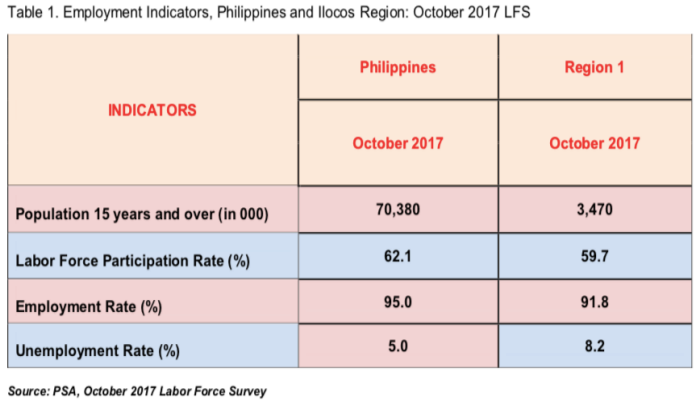
Among the regions, Ilocos Region (Region I) recorded the lowest employment rate at 91.8 percent in October 2017. On the other hand, Cagayan Valley (Region II) had the highest employment rate at 97.9 percent. Meanwhile, National Capital Region (NCR) recorded the next lowest employment rate among the seventeen regions in October 2017 at 93.9 percent. Likewise, Central Luzon (Region III) and CALABARZON (Region IVA) and Western Visayas posted employment rates below the national figure at 94.0 percent, 94.3 percent and 94.4 percent, respectively.
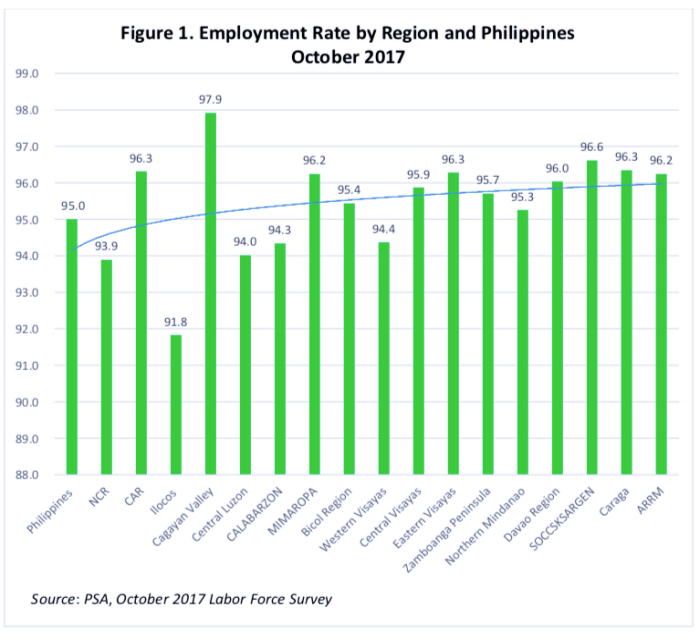
There was an increase of 0.5 percentage point in the number of employed males in Ilocos Region from 64.7 percent in October 2016 to 65.2 percent in October 2017. On the other hand, a decrease of 0.5 percentage point was also recorded among the employed females, from 35.3 percent in October 2016 to 34.8 percent in October 2017.
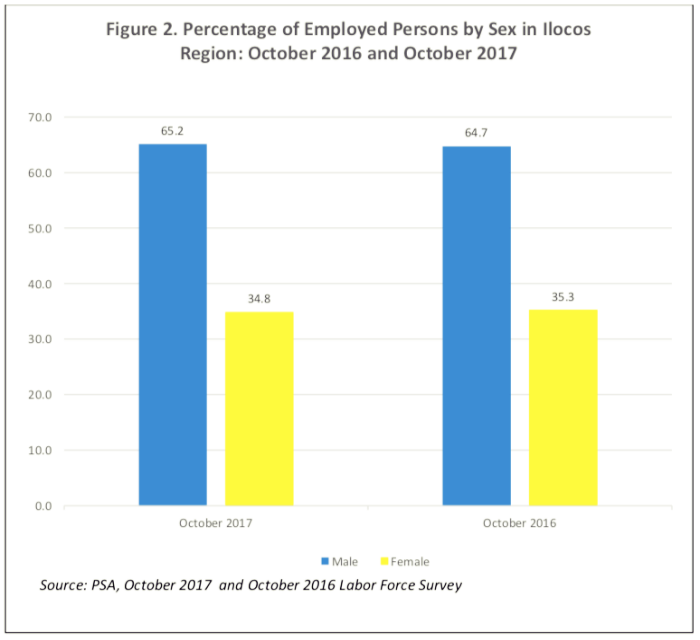
In terms of the magnitude of employed persons by sex, employed males decreased by 46 thousand from 1,286 thousand in October 2016 to 1,240 thousand in October 2017. Likewise, the number of employed females decreased by 39 thousand in October 2017 from 701 thousand in October 2016 to 662 thousand in 2017.

By education, 28.5 percent of the employed persons in Ilocos Region have reached college and this was higher by 1.6 percentage points as compared to the figure for the Philippines.
For secondary level, 47.3 percent of the employed persons in the Ilocos Region attained Junior and Senior high school, which was higher by 6.0 percentage points than the 41.3 percent recorded for the whole country in October 2017.
On the other hand, 4.8 percent of the employed persons in Ilocos Region attained post-secondary level, which was 0.1 percentage point higher than the 4.7 percent recorded for the whole country during the said period
About 19.1 percent of the employed persons in Ilocos Region attained elementary level, lower by 6.7 percentage points compared with that of the national level at 25.8 percent.
The percentage of employed persons in Ilocos Region with no grade completed was only 0.3 percent, and this was lower by 1.1 percentage points for the Philippines at 1.4 percent in October 2017.
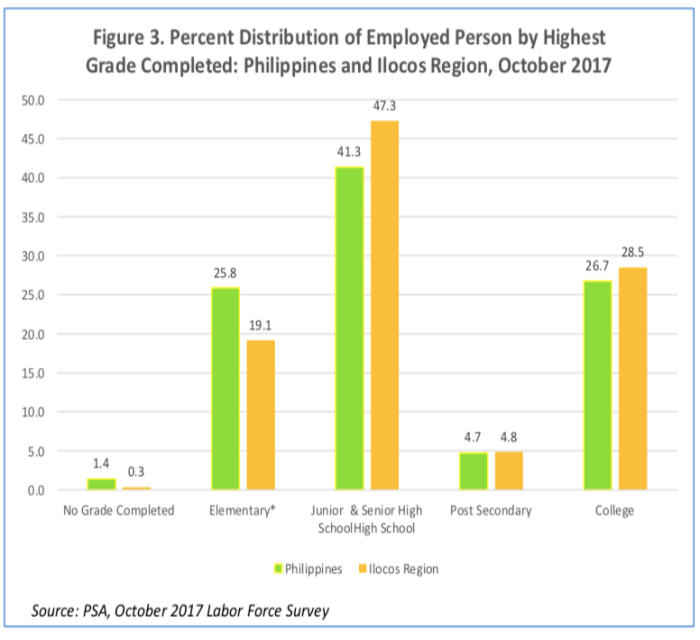
Among the various occupation groups, workers under elementary occupations comprised the biggest group making up 30.6 percent in October 2017 and 31.6 percent in October 2016.
Service and sales workers made up the second largest occupation group in Ilocos Region accounting for 15.3 percent in October 2017 while the skilled agricultural, forestry and fishery workers was the second largest occupation group with 17.1 percent in October 2016.
Officials of the government and special interest organizations, corporate executives, managers, managing proprietors and supervisors was the third biggest group with 15.2 percent in October 2017, while service and sales workers with 16.4 percent was the third group in October 2016. Skilled agricultural, forestry and fishery workers was the fourth biggest occupation group with 12.7 percent in October 2017. Meanwhile, officials of the government and special interest organizations, corporate executives, managers, managing proprietors and supervisors was the fourth largest group with 13.1 percent in October 2016.
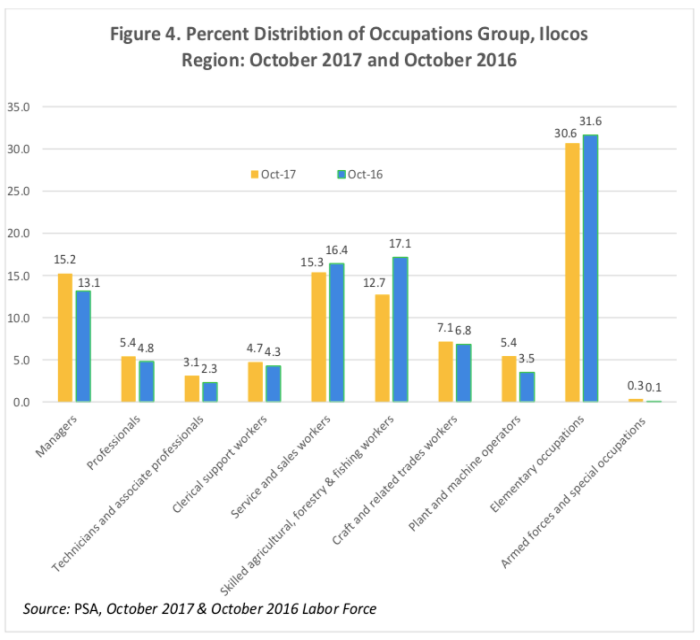
In terms of the percent distribution of employed persons by major industry, workers in the services sector accounted the largest group, making up 56.7 percent and 52.3 percent of the total employed in Ilocos Region in October 2017 and October 2016, respectively.
Workers in the agriculture sector, on the other hand, comprised the second largest group in Ilocos Region, accounting for 26.7 percent and 33.6 percent in October 2017 and October 2016, respectively.
Meanwhile, workers in the industry sector made up 16.6 percent of the total number of employed persons in Ilocos Region in October 2017, and 14.1 percent in October 2016.
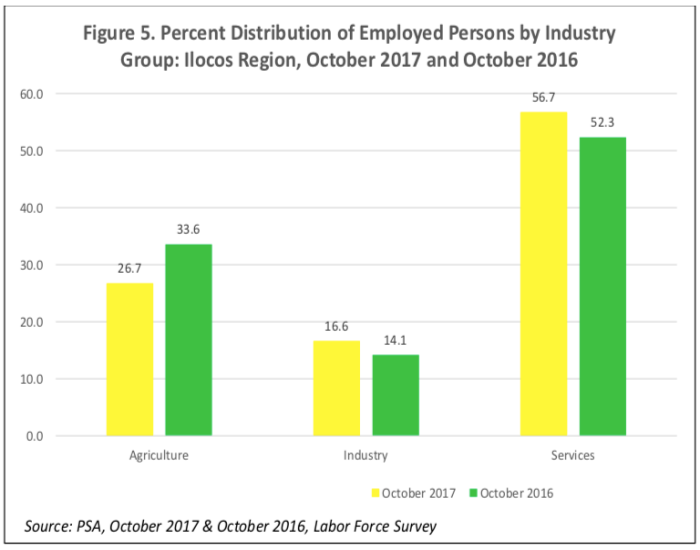
About 64.0 percent of the employed persons in Ilocos Region worked as wage and salary workers in October 2017. The figure was higher by 5.6 percentage points as compared to the estimate obtained in October 2016 with 58.4 percent. Own account workers ranked second in October 2017 with 20.8 percent of the total employed persons in Ilocos Region. This was lower by 6.2 percentage points as compared to October 2016 with 27.0 percent. Employer in own family operated farm or business ranked third with 9.6 percent in October 2017, which was higher by 3.9 percentage points as compared to that in October 2016 with 5.7 percent. Unpaid workers recorded 5.5 percent in October 2017 which was lower by 3.4 percentage points as compared to that in October 2016 with 8.9 percent.
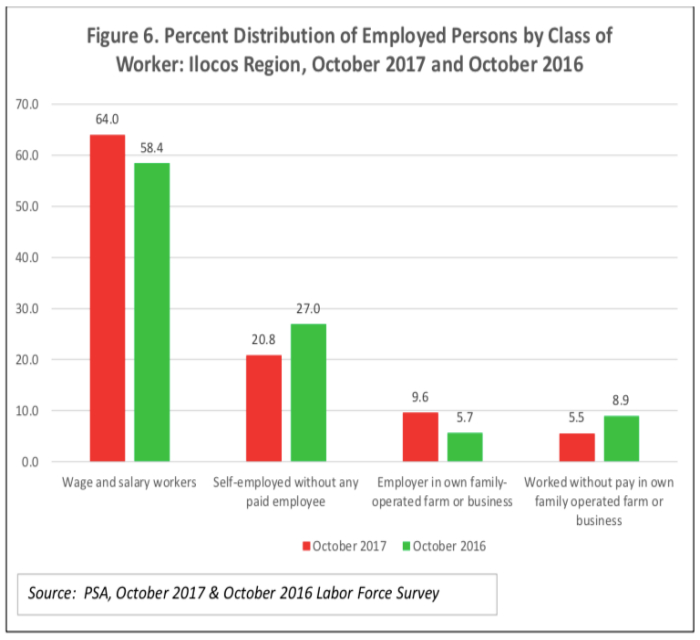
For wage and salary workers, those working in private establishment was the biggest group with almost half (47.6 percent) in October 2017, which was higher by 3.2 percentage point as compared to October 2016. Employed persons who worked for government or government-controlled corporation shared 10.6 percent in October 2017,
higher by 1.9 percentage points as compared to that in October 2016 with 8.7 percent. On the other hand, the proportion of individuals who worked for private households was 5.7 percent in October 2017, higher by 0.6 percentage point as compared to 5.1 percent in October 2016. A small percentage of 0.1 percent and 0.2 percent in October 2017 and October 2016, respectively was reported for those persons who worked with pay in own-operated farm or business.
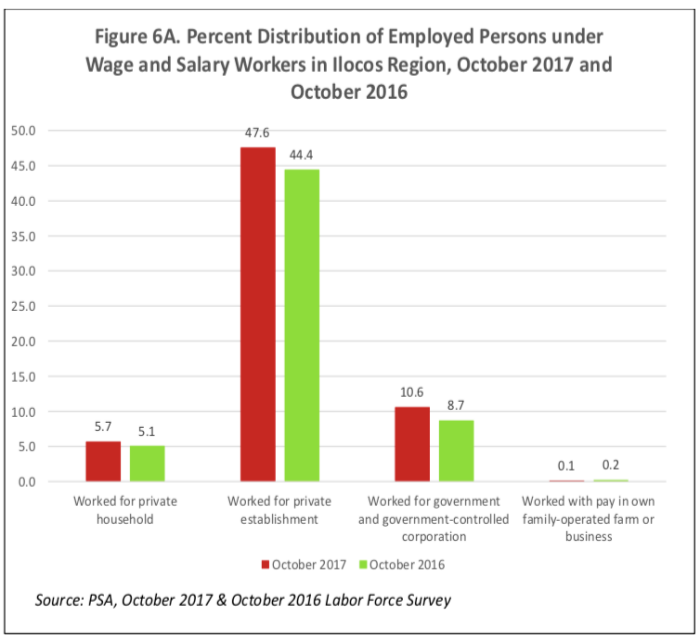
The most common job search method used by unemployed persons in Ilocos Region was “approached employer directly” with 38.9 percent which was higher than the national figure of 36.4 percent. Unemployed persons in Ilocos Region who “approached relatives or friends” to search for a job recorded the second highest job search method with 36.1 percent, while 31.4 percent with that of the national level. Meanwhile, “place or answered advertisements” recorded 13.9 percent and the third highest job search method recorded in Ilocos Region in October 2017 as compared with the country’s mark (5.5 percent), in the same period. Meantime, “registered to private employment agency” job search method, accounted only 8.3 percent in Ilocos Region which was lower by 9.3 percentage points compared to 17.6 percent for the Philippines during the same period.
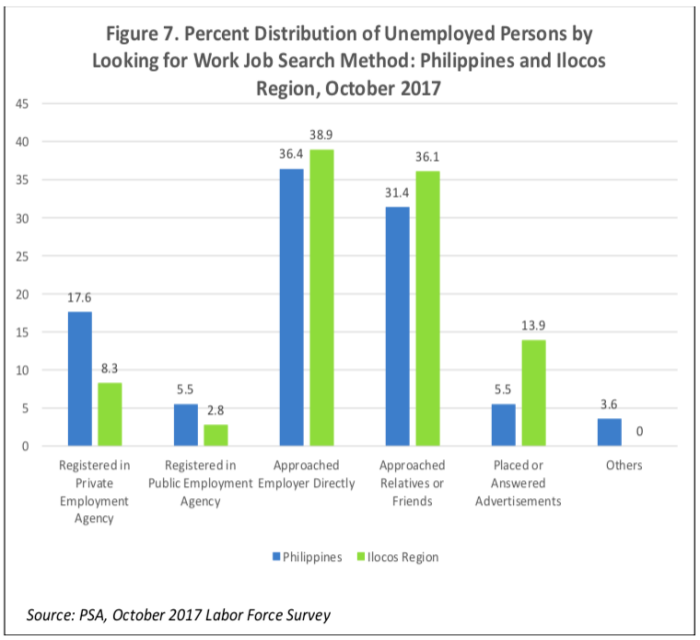
Statistical Tables
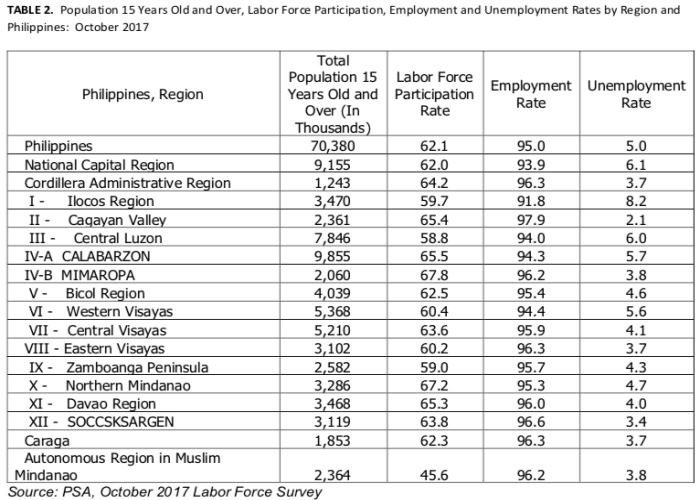
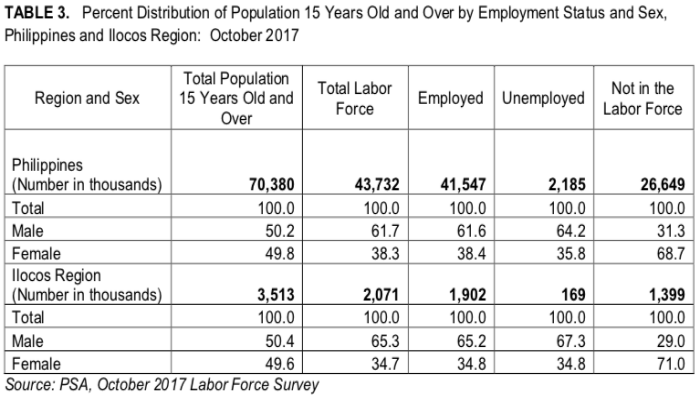
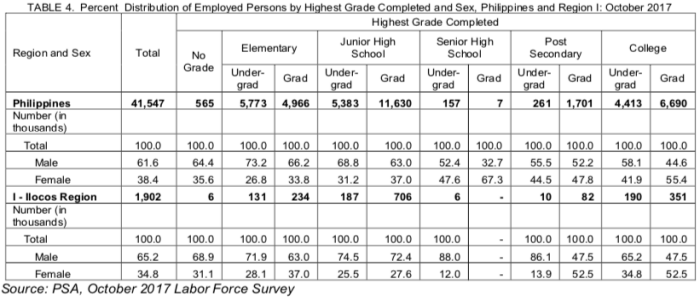
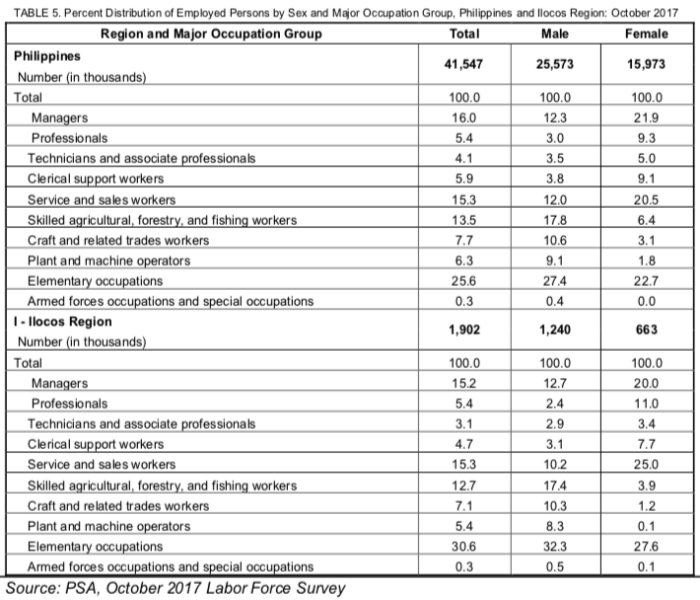
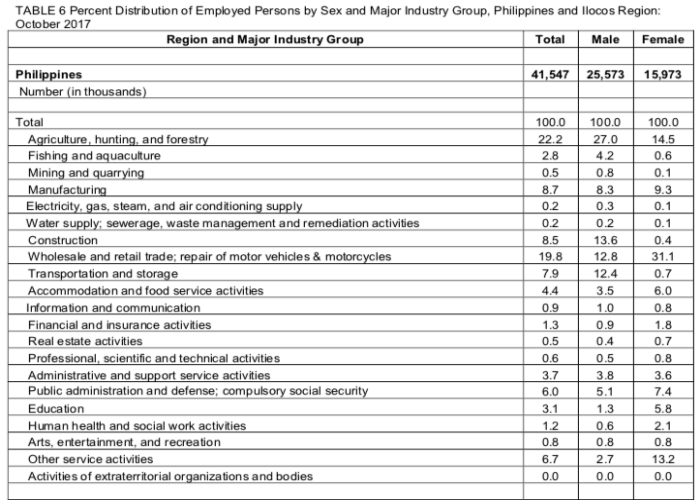
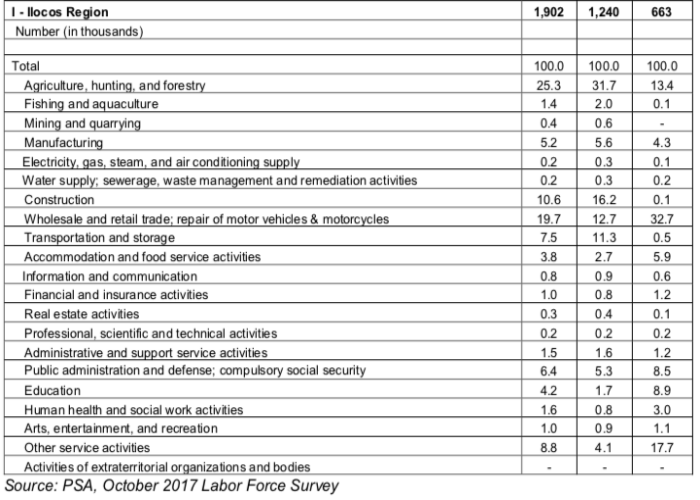
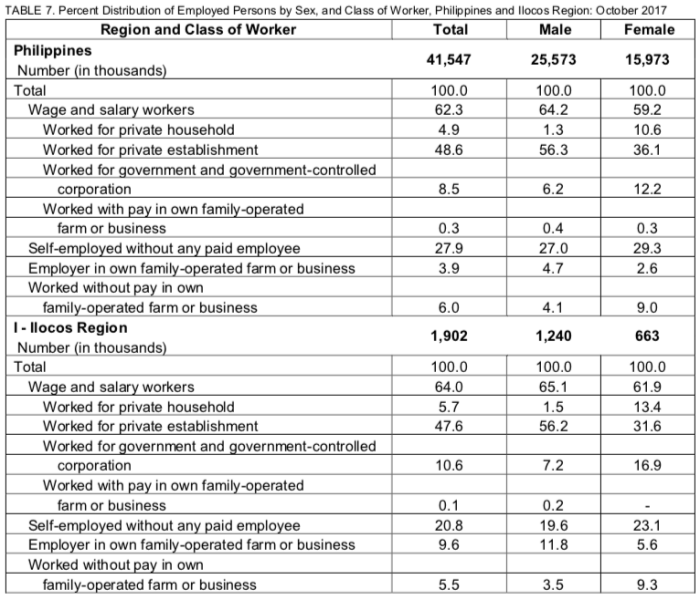
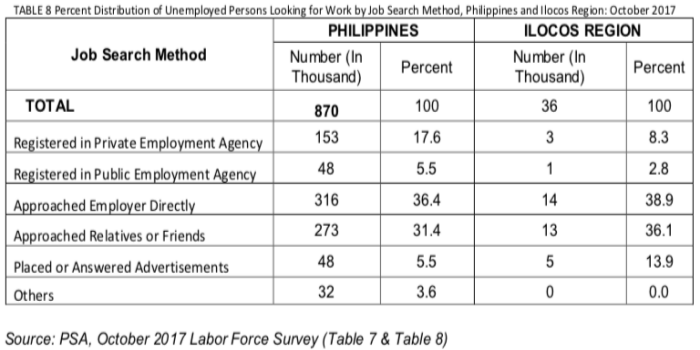
TECHNICAL NOTES
-
Starting July 2003, the Labor Force Survey (LFS) adopted the 2003 Master Sample Design, with a sample size of approximately 50,000 households.
-
Starting in the January 2012 LFS, the codes for industry adopted the 2009 Philippine Standard Industrial Classification (PSIC). Prior to this, codes for industry used the 1994 PSIC.
-
Starting in the January 2012 LFS, more detailed categories for highest grade completed used in the 2010 Census of Population and Housing (CPH) were also adopted.
-
Starting in the January 2012 LFS, a question on whether a household member is a graduate of a technical vocational course was asked for each person 15 years or older.
-
Starting April 2005, the new unemployment definition was adopted per NSCB Resolution Number 15 dated October 20, 2004. As indicated in the said resolution, the unemployed include all persons who are 15 years and over as of their last birthday and are reported as: (1) without work and currently available for work and seeking work; or (2) without work and currently available for work but not seeking work for the
following reasons:
-
Tired/believed no work available
-
Awaiting results of previous job application
-
Temporary illness/disability
-
Bad weather
-
Waiting for rehire/job recall
-
Starting with the January 2007 LFS round, the population projections based on the 2000 Census of Population and Housing was adopted to generate the labor force statistics. This is in compliance with NSCB Resolution No. 1 series of 2005 entitled“Adoption of the Methodology Used in Generating the 2000 Census of Population and Housing-Based National Population Projections”.
-
The 2012 Philippine Standard Occupational Classification (PSOC) was adopted starting April 2016.
SGD. SOCRATES L. RAMORES
Regional Director

